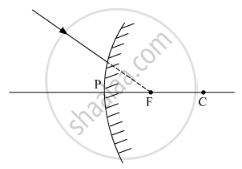Advertisements
Advertisements
Question
A 5 cm tall object is placed perpendicular to the principle axis of a convex lens of focal length 12 cm. The distance of the object from the lens is 8 cm. Using the lens formula, find the position, size and nature of the image formed.
Solution
u = −8 cm
f = 12 cm
h = 5 cm
Now lens formula is
`1/v-1/u=1/f`
Putting Values
`1/v=1/12+1/-8`
`=1/12-1/8`
`=(2-3)/24=-1/24=>v=-24`cm
Thus, image is formed 24 cm on the left of convex lens i.e. on the side of the object.
Now magnification is `m =v/u=h^'/h`
`(-24)/(-8)=h^'/5`
h′ = 15 cm (Positive)
The height of the image is 15 cm which is 3 times larger than the height of object.
Thus, we can say image is virtual, enlarged and erect.
APPEARS IN
RELATED QUESTIONS
If the image formed by a spherical mirror for all positions of the object placed in front of it is always erect and diminished, what type of mirror is it? Draw a labelled ray diagram to support your answer.
Which type of mirror has:
positive focal length?
State the relation between object distance, image distance and focal length of a spherical mirror (concave mirror or convex mirror).
Fill in the following blank with a suitable word:
A ray of light which is parallel to the principal axis of a convex mirror, appears to be coming from ............ after reflection from the mirror.
Two big mirrors A and B are fitted side by side on a wall. A man is standing at such a distance from the wall that he can see the erect image of his face in both the mirrors. When the man starts walking towards the mirrors, he find that the size of his face in mirror A goes on increasing but that in mirror B remains the same.
(a) mirror A is concave and mirror B is convex
(b) mirror A is plane and mirror B is concave
(c) mirror A is concave and mirror B is plane
(d) mirror A is convex and mirror B is concave
What is the effect on the size and position of the image of moving the object (i) towards the lens, and (ii) away from the lens?
Explain why, a real image can be projected on a screen but a virtual image cannot.

Why are the mirrors fitted on the outside of cars convex?
Higher-Order Thinking Skills:
A convex mirror is in water. What should be the change in its focal length?
